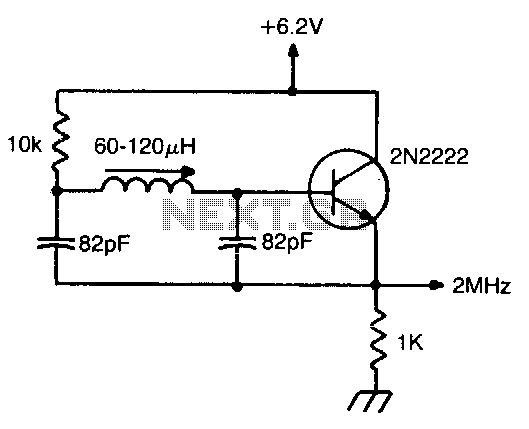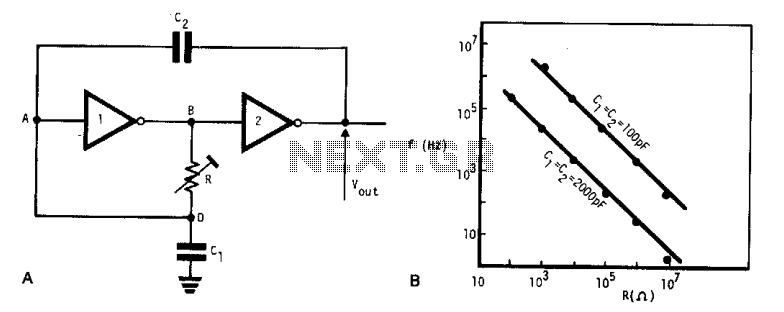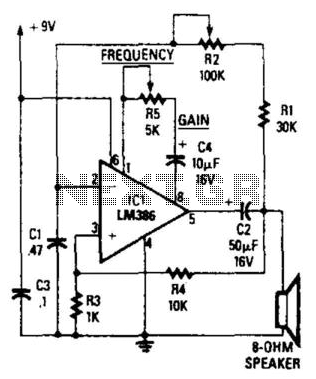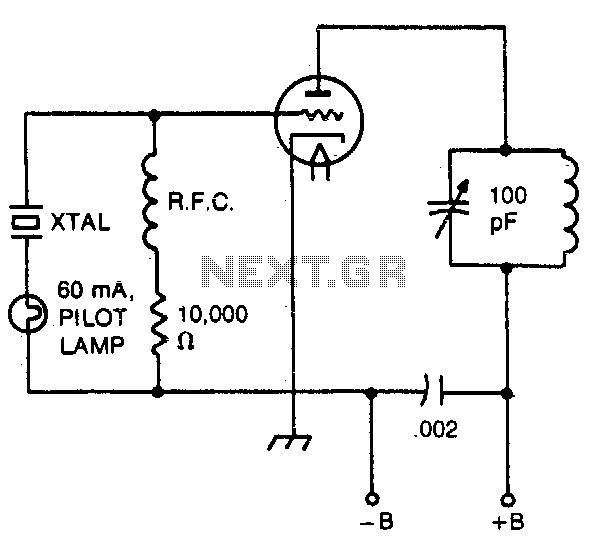
2Mhz oscillator

Miller 9055 miniature slug-tuned coil; all resistors 1/4W 5%; all capacitors minimum 25 V ceramic.
The Miller 9055 miniature slug-tuned coil is designed for applications requiring precise tuning and compact form factors. This coil is characterized by its miniature size, allowing it to be integrated into various electronic circuits where space is limited. The slug-tuned feature enables fine adjustments to the inductance, which is crucial for optimizing circuit performance in RF applications, such as oscillators, filters, and amplifiers.
All resistors in the circuit are specified to be 1/4W with a tolerance of 5%. This ensures that the resistors can handle the power levels typically encountered in such applications while maintaining a reasonable level of accuracy in their resistance values. The choice of 5% tolerance allows for cost-effective components while still meeting the performance requirements for most applications.
The capacitors utilized in the circuit are specified as a minimum of 25 V ceramic capacitors. Ceramic capacitors are known for their stability, low leakage, and high-frequency performance, making them suitable for RF applications. The 25 V rating indicates the maximum voltage that the capacitors can safely handle, providing a margin of safety for circuit operation.
Overall, the combination of the Miller 9055 coil, 1/4W resistors, and 25 V ceramic capacitors creates a reliable and efficient circuit design suitable for various electronic applications where size and performance are critical.Miller 9055 miniature slugtuned coil; all resistors 1/4W 5%; all caps min 25 V ceramic. 🔗 External reference
The Miller 9055 miniature slug-tuned coil is designed for applications requiring precise tuning and compact form factors. This coil is characterized by its miniature size, allowing it to be integrated into various electronic circuits where space is limited. The slug-tuned feature enables fine adjustments to the inductance, which is crucial for optimizing circuit performance in RF applications, such as oscillators, filters, and amplifiers.
All resistors in the circuit are specified to be 1/4W with a tolerance of 5%. This ensures that the resistors can handle the power levels typically encountered in such applications while maintaining a reasonable level of accuracy in their resistance values. The choice of 5% tolerance allows for cost-effective components while still meeting the performance requirements for most applications.
The capacitors utilized in the circuit are specified as a minimum of 25 V ceramic capacitors. Ceramic capacitors are known for their stability, low leakage, and high-frequency performance, making them suitable for RF applications. The 25 V rating indicates the maximum voltage that the capacitors can safely handle, providing a margin of safety for circuit operation.
Overall, the combination of the Miller 9055 coil, 1/4W resistors, and 25 V ceramic capacitors creates a reliable and efficient circuit design suitable for various electronic applications where size and performance are critical.Miller 9055 miniature slugtuned coil; all resistors 1/4W 5%; all caps min 25 V ceramic. 🔗 External reference
Warning: include(partials/cookie-banner.php): Failed to open stream: Permission denied in /var/www/html/nextgr/view-circuit.php on line 713
Warning: include(): Failed opening 'partials/cookie-banner.php' for inclusion (include_path='.:/usr/share/php') in /var/www/html/nextgr/view-circuit.php on line 713





